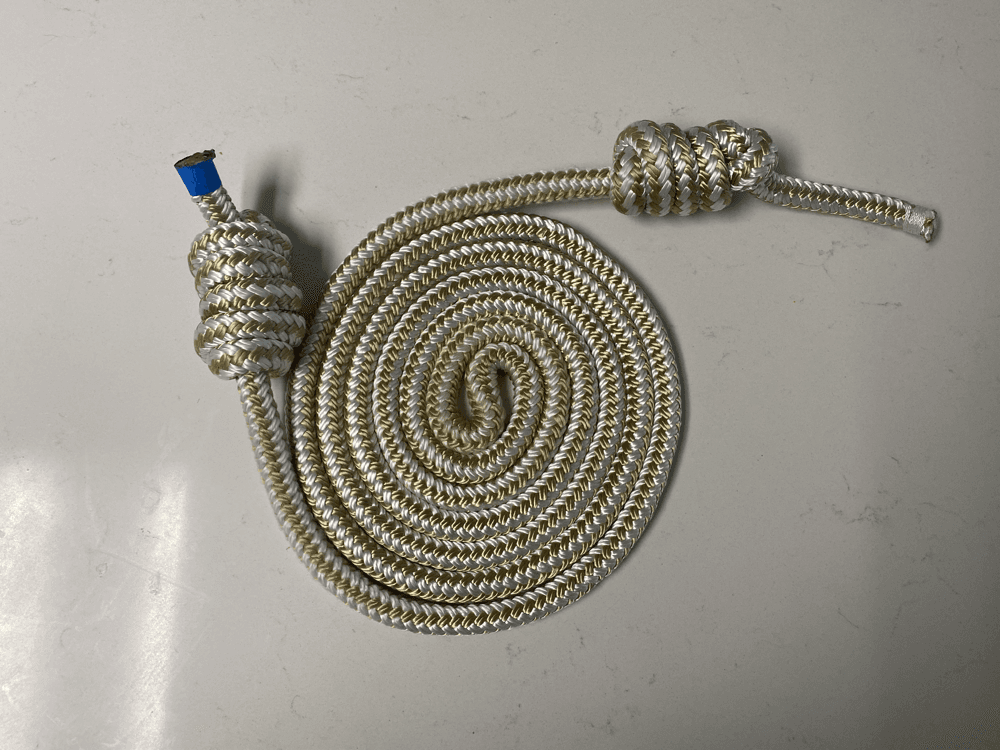
DIY Flow Rope
Published: Apr 21, 2025
In this DIY and crafts challenge, I learned how to make a piece of workout equipment called a “flow rope”. In the process, I learned how to tie a stopper knot called a heaving line knot and learned some things about cutting and finishing ropes to prevent fraying.
Flow ropes are used for a relatively new movement practice called “rope flow”. Rope flow, like jump roping, uses a rope to encourage rhythmic movement, but it is a more low-impact exercise that involves swinging and moving the rope around the body without jumping over it. It has got a martial arts quality to it, like twirling around a bo staff, and there are tons of skills and tricks to learn. Check out an introduction to rope flow by the Youtube channel Strength Side here if you are curious to learn more about it:
Flow ropes are generally thicker and heavier than jump ropes. Some people have worked up to using absolutely massive ropes that you might find on a pirate ship. The rope that I made is 1/2” thick. I modeled my rope on “The Golden Teacher”, the rope that Tim’s Gym uses. Tim's Gym is a great resource for learning about rope flow (and other fitness related topics) and I liked the look of the rope that he uses. I found "The Golden Teacher" to be a half inch rope through some googling. This is considered the most popular and recommended size, especially for beginners.
The Golden Teacher sells for £44, which at the time of writing this is $58. I saved some money by buying a piece of 15 foot long marine rope for just $14 instead and cutting and tying it myself. You can also use climbing rope and other quality double braided ropes. If you wanted to make these things at scale, you could get a long climbing rope and make several of these for the price of one climbing rope. They take basically no time to make also. I also learned how to tie a new knot, learned a little about finishing rope ends, and kept my spirit of DIY alive by opting to make my own instead of just buying one.
Here's a video tutorial on how to make a flow rope:
Here are written instructions for how I made mine:
How I Made a Flow Rope
Supplies
- a piece of 1/2” thick rope that is at least 12 feet long.
- masking tape
- a sharp knife
- a lighter
Instructions
- Tie a heaving line knot on the first end of your rope. Measure out your arm’s length of rope or around 36 inches. Bend the rope at that point. Tie the end around the rope about 1/3 of the way down your loop. Tie 4 or 5 loops around your rope and pull the end through the loop. Then, grab the handle you just made with the loops and pull it tight towards the end.

- Hold the end of your rope, stand on it and measure out a length that comes up to the bottom of your rib cage on both sides.
- Once you have that length, add another arm’s length (or 36 inches) to calculate the total length of your flow rope and to mark the place where you will cut the rope.
- Wrap masking tape tightly around the place where you will cut. This is done to minimize rope fraying when you cut it.
- Use a sharp knife and cut as cleanly as you can through it
- There are many techniques to finish a rope end. I just used a lighter to fuse the end to prevent fraying.
- Make another heaving line knot using the same technique as described above on this end.
Most flow ropes are around 8 feet long. A lot of people find that if you extend your arm out and hold the two handles and hold the other end of the rope with your other arm, that the rope should touch your opposite shoulder. If yours needs to be adjusted you can add an “overhand knot” or a “figure eight knot” to your rope to shorten it.
Overall, this is a quick and easy DIY project that I enjoyed making. I not only saved some money by making my own rope, but got introduced to the world of knots by learning the heaving line knot to make the flow rope handles. This project made me realize the utility of learning some different categories of knots. I am now curious to learn and explore more in the surprisingly big world of knot making.
Since making my rope, I have learned some basic rope flow moves (the overhand, the underhand, and the dragon roll), and I can see why there are many passionate enthusiasts for this movement practice. You can get lost in the rhythm of it and it is less tiring than something like jumping rope, so it feels more like a meditation. There are tons of tricks to learn, so it opens a lot of room for growth and exploration. It feels like a good light healthy exercise to get the spine and shoulders moving well and to build full-body coordination skills. I am glad I made my own rope and I'm eager to explore and learn more about "rope flow".